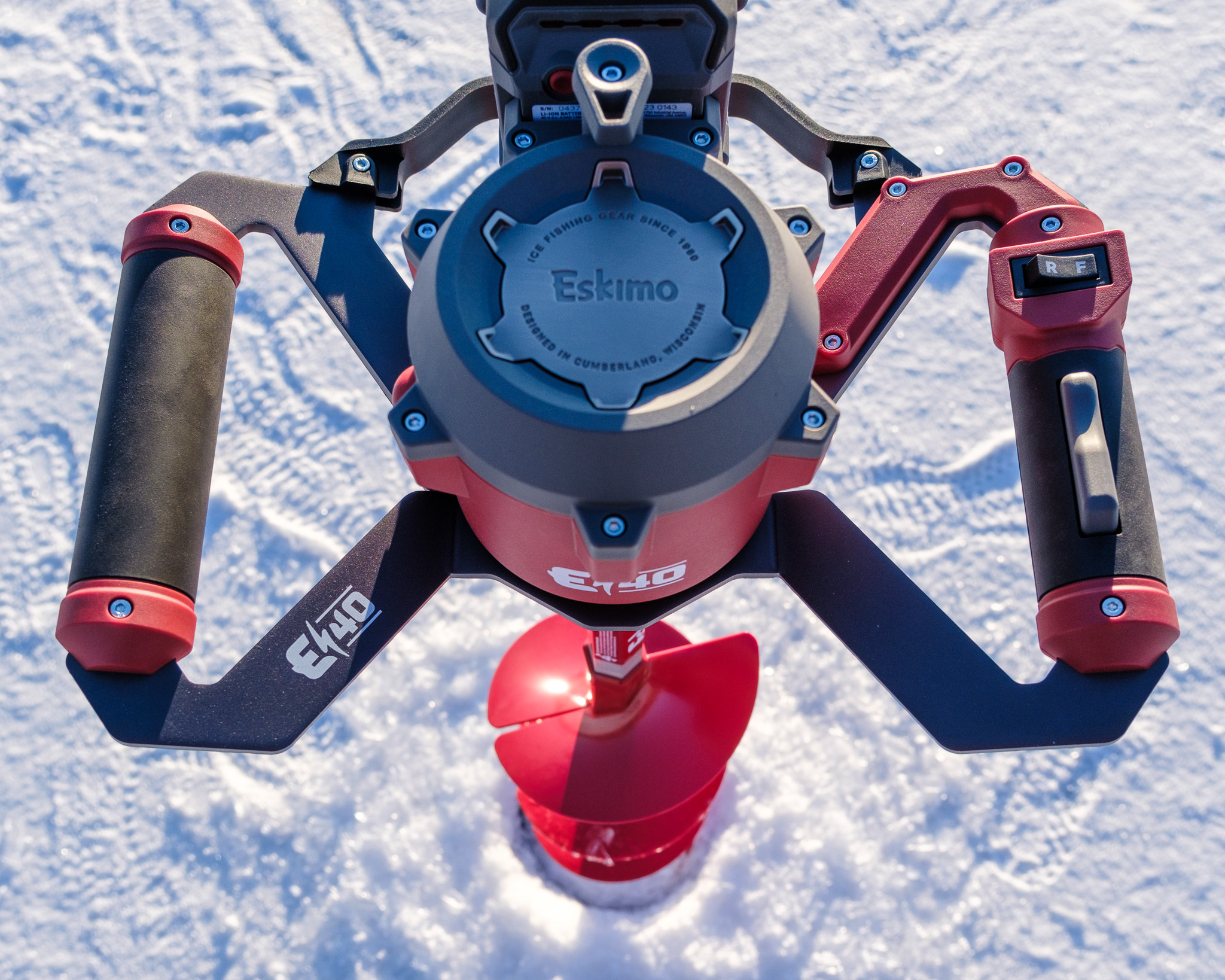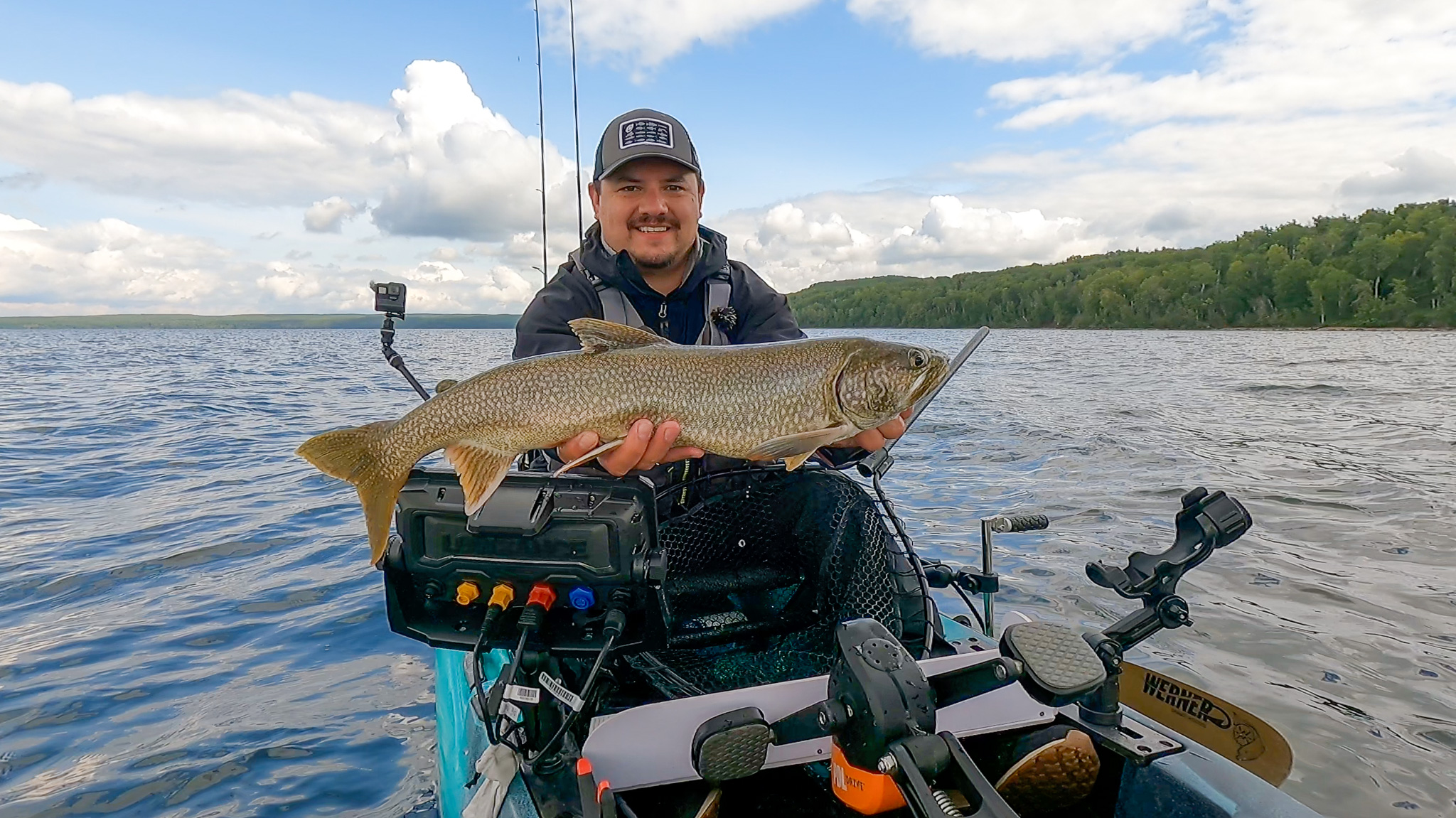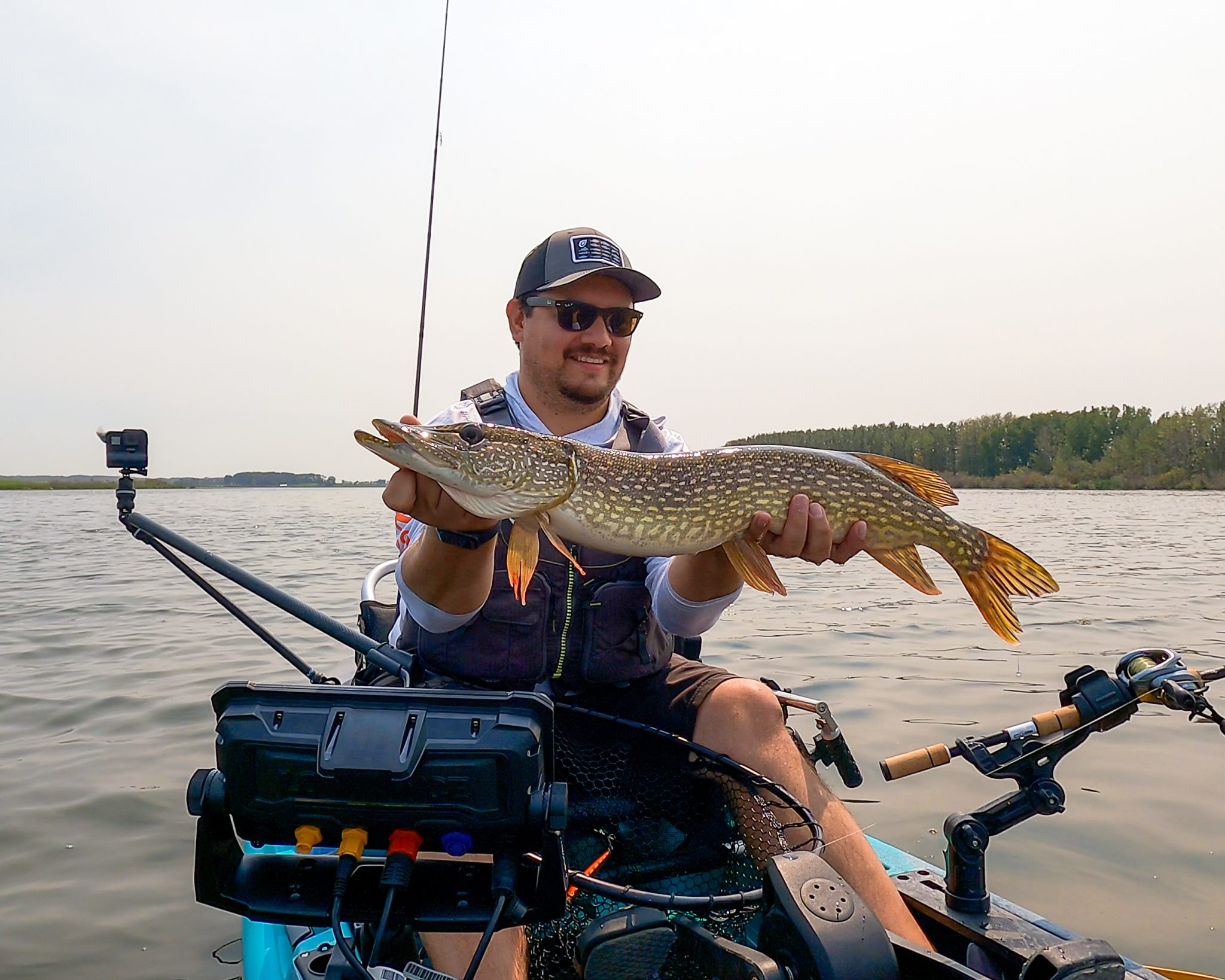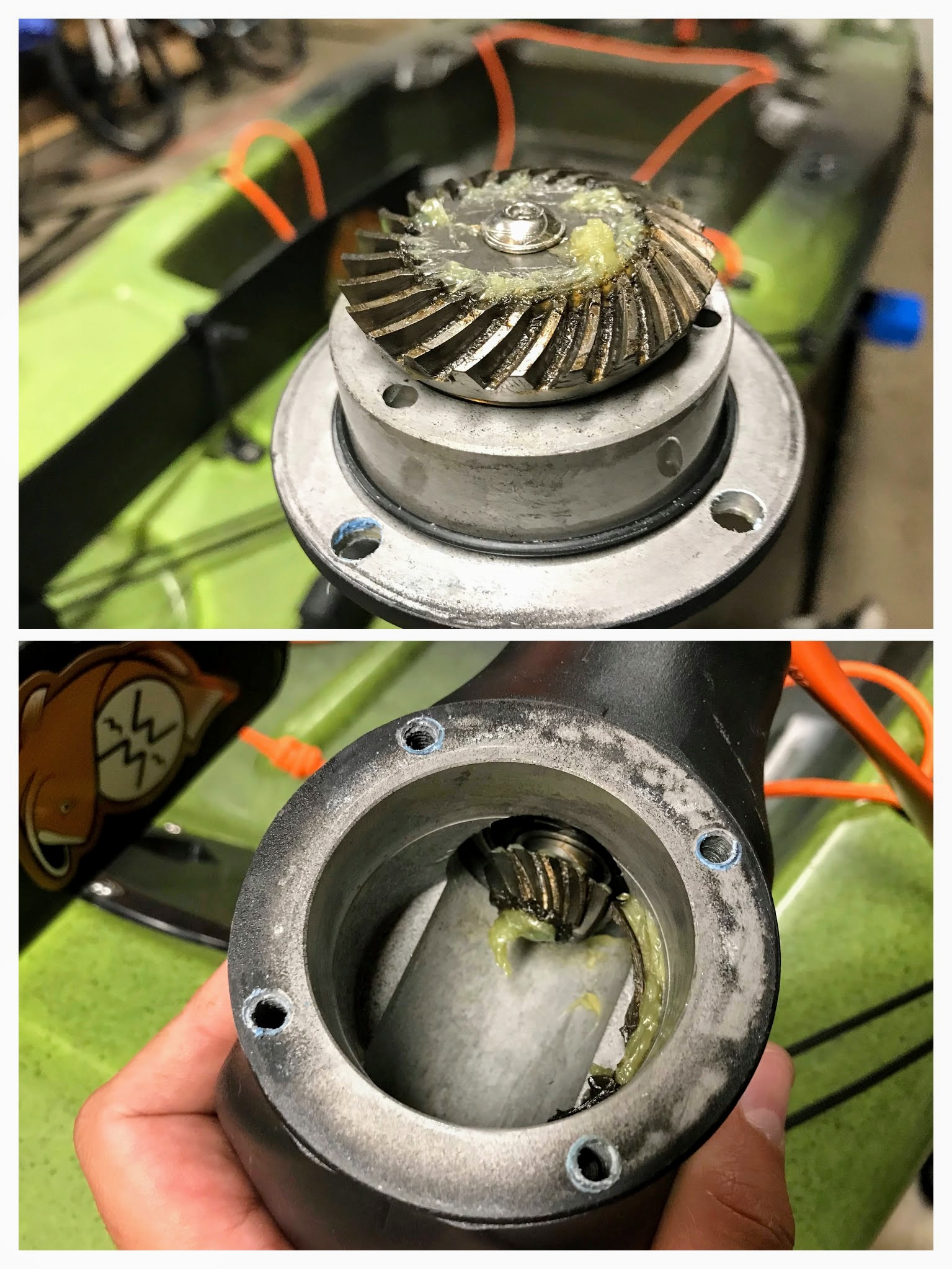My Perception Pescador Pilot 12.0 is now three years old and to celebrate I would like to share my thoughts on the kayak and give it a bit of a review. Perception introduced the Pescador Pilot 12.0 in July 2016 it has been relatively unchanged since. The Pilot has all the features I wanted when I upgraded to a pedal drive and I have been happy with my purchase so far. I bought the Pilot second hand off a friend after he used it for a year, it was in very good shape when I bought it and has held up well to my style of abuse.
My previous kayak was a 2015 Ocean Kayak Trident 13. It was an excellent kayak, not just for a first boat but season after season I appreciated a lot of its features. In my opinion the only thing it lacked was the ability to stand and cast. I wouldn’t have sold it if my friend didn’t offer up a great deal on a gently used pedal drive kayak.
Things I like:
I love the pedal drive. The ability to control the boat with your feet while keeping your hands free is an absolute game changer. With the drive I am able to troll with the rod in my hands, travel from spot to spot while eating a snack or playing with the fish finder, control the boat in the wind and hold a spot without the use of an anchor. It really feels like cheating.
I can now stand and cast. It is great to be able to sight fish from the kayak using both a spinning rod or a fly rod. The few feet gained from sitting to standing allows you to see much further out and into the water.
The kayak is very stable. It gives me a lot of confidence on big lakes when I am able to move around the kayak from front to back or to stand up and turn around if necessary.
The ride is dry compared to my last kayak. On my previous kayak the seat was integrated into the hull. So when the hull got wet my butt got wet. On the Pilot the seat is a few inches off the deck, so when some water comes through the scuppers or I end up spilling my drink it doesn’t all end up on my seat. Also since I am not using the paddle as often I don’t get the drips on my lap.
I like the built in gear tracks. I thought there might have been an issue with strength because they are made of plastic but they have held up great. Last summer I was floating down the North Saskatchewan River with my rod in the rod holder and snagged my jig head on the bottom. The rod doubled over and because of the current the boat whipped around and almost flipped. Luckily I was able to get the rod out of the holder before I went for a swim. The rod holder and gear track it was mounted to showed no sign of weakness.

The seat is very breathable. This is a very nice feature most of the year but it can be chilly when the weather is cold.
The extended range afforded by pedaling is awesome. I can go much farther and much faster than paddling allowed before. And if my legs do get tired I can always paddle for a bit as well.
The transducer mounting location is great for my side imaging sonar. There is no interference from the pedal drive or noise from the hull interfering with the side imaging signal, which was an issue on my previous kayak.
The drive itself is quiet. There is virtually no turbulence thanks to the rubber flaps on the bottom.
Things I don’t like:
The drive is a pain to retract. In order to pull up the drive you have to pull some pins, line up the propeller so its vertical, push it up with one hand and slide the pin in with the other. Which is fine when the water is clear enough you can see the prop, but when the water is dirty and your prop is misaligned with the crank arms it becomes a game of retract the prop before you run aground. The pins that have to be pulled and pushed when raising or lowering the drive are greasy and it gets all over your hands, if they are not greased the pin squeaks when you pedal and gets old real quick.

I cannot get comfortable in the seat. If I sit up straight my butt rests on the bar at the back, if I lean back on the backrest I put too much pressure on the straps when pedaling and they start to tear and slip through the buckle. In an attempt to stop the slipping I roughed up the buckles with a file but that only delays the backrest leaning all the way back.

There is no dry storage. I like to be able to keep some things dry like a change of clothes or my lunch when I am out on the kayak. The only hatch is the small one in the back and that is pretty much only for rudder maintenance. Its big enough for my hand to fit in but not much else.
The rod holders behind the seat are terrible. I don’t use them and don’t plan to.
Points to note:
There are some things I’ve learned to be aware of when using my Pescador Pilot.
Keep the weight balanced left to right otherwise the kayak will be tilted to one side as you pedal around. This is not a big deal but can make you lean to one side all day.
Point the rudder so it is in line with the cables when raising or lowering it. This makes it much easier to pull up and down because you need quite a bit of leverage to do it when the ropes are not aligned.

Water does get into the hull so it’s a good idea to open the hatch when you get home. The water most likely gets in through the hole the rudder is mounted to when waves splash over the top, but it also gets in when you forget the put the plug back in.

When the drive is retracted the pedals block access to one of the boxes. I usually align the pedals so the box that is blocked is the one I keep things I don’t regularly need, such as my throw bag and bailing bucket.
The shaft that holds the drive in will rotate as you pedal, if you keep the wire for the cotter pin through the split ring it will wind the wire up and pull the cotter pin from the other shaft.
Maintenance:
Maintenance on the kayak has been pretty minimal. I covered it in detail in a previous post and you can find here: https://www.stringtheoryangling.ca/pescador-pilot-12-0-drive-issue-and-maintenance/
Things that have worn after 3 years:
There are a few things that are wearing out slowly and will likely need to be replaced in the next year or two:
The straps on the seat are starting to break, the mounting holes on the straps are stretching out and tearing from the force I put on the backrest. In addition to that the buckles do not want to hold the backrest in place. I attempted a simple fix by roughing up the buckle with a file to hold the straps better. It helps but doesn’t prevent the backrest from sliding back to the max-relax position.


To prevent the metal seat from wearing a hole in the hull I put a piece of pipe insulation on the bar that contacts the plastic.

The seat is starting to show signs of sun damage. I keep the kayak indoors when not in use and if the seat gets wet I don’t allow it to dry in the sun. I am sure when the time comes to replace the fabric I will be able to get a new seat from Perception so I’m not too worried about it.
The paddle bungee cord has stretched out and lost some of its elasticity. I plan on adding a paddle clip to this location anyway as the bungee strap doesn’t hold the paddle very rigidly.
Conclusion
I outlined a lot of things to be wary of in this post but keep in mind each kayak will have its own quirks you will have to deal with, it’s not a one size fits all situation. One of the benefits of fishing from a kayak in general is that everything you need is within arms reach, which is not usually the case in a boat. There is also no limit to what you can do to make your kayak your own. There are so many accessories available from great manufacturers and DIY’ers, with more coming out each year. Overall I have been very happy with my Pescador Pilot 12.0, it is a real angling battleship!





My PPP is now about the same age as yours. It is holding up wonderfully!
It has been used exclusively for salt and brackish waters. I can’t tell you how many times I have run aground on oyster bars with the drive down. I still have not yet worn through the coating.
When I get to shallow waters I usually don’t tuck the drive all the way up since it is a pain in my murky waters. I just pull the pin and fold the drive up until the prop contacts the hull. Then hold it forward with my foot until I get through the shallow parts of the flats. That makes it a much faster and much less of a pain. Draft is only maybe 4″ at that point… which has always been enough.
I have no intention of buying a different yak. All repair parts can be ordered online as mentioned. She work and works well. Best upgrade… cutting out the OEM rod holders and riveting in some Yak Gear flush mounts.
I set two to face outwards for dual trolling. The others facing rear/at a slight angle so as to not hit the cooler.
I’m glad your kayak is still holding up well! I’ve managed to wear a bit of the coating on the drive away but that just adds some character, right? Half tucking the drive is a good tip, and the rod holder upgrades add a lot of functionality. Thanks for the great comment, Martin!
I have designed a great mount for a trolling motor if you are interested in seeing it.
Hi Raymond, I’d love to see your trolling motor mount! Please post up a picture when you get a chance.
Thanks for this piece, Chris. I am hoping to begin trolling for chinook salmon. I assumed I would need to upgrade the gear trac to the GT90 aluminum material,as well as add a backing plate underneath. Your words on the original poly trac material have me wondering if I need to actually do this or not. There are pitfalls to attempting it. See below:
In my research, I’ve learned that the current mount, which uses just 3 screws rather than the 7 screw holes provided by all retail-sold 12″ YakAttack gear tracs, has failed on a couple folks I know of. I’ve learned that Perception molded in a “nipple” of plastic where these 3 screws are. So, rather than being simply screw-mounted into thin plastic, the screws go into a nipple that appears to extend at least 1/2″ deep below the surface. Is this enough to slap a rod holder onto and troll for 20lb. chinook salmon? Any effort to reinforce the trac with a continuos 12″ backing plate would be fruitless due to the nipples being in the way. One genleman addressed this by “drilling out” each nipple for a continuos 12″ backing plate (mfr YakAttack) installation…learning that it took a 1/2″ bit to successully remove all of the nipple. Sounds good, but now 3 of your seven holes for size 10 screws are 1/2″ diameter. I’m working on my own possibile solutions, which include perhaps two seperate 4 1/2″ long custom DIY backing plates, one on each side of the center screw, to eliminate having to drill out the nipples. Anyway, I am glad to read that you gave the current configuration a pretty good test and that it held. Perhaps I’m worried about an issue that does not need to be worried about.
I’m glad you enjoyed this article, Chris! It’s been a year since I wrote this and, more importantly, another year of use and abuse of the plastic gear tracks. I’m still impressed with how well they have held up and are still not showing signs of wear or breakage.
I haven’t personally used the gear tracks to troll for anything as large as a salmon as I’m in a landlocked province. However, with an appropriate action rod and drag setting, I honestly don’t believe you should have a problem.
Now, if you did run into issues and pull the track out while trolling, you could then go down the road of adding the aluminum YakAttack gear tracks. I don’t think you have anything to lose by trusting the plastic tracks first before going though the trouble of replacing them right off the bat. I hope this helps and thanks for the great comment!
Chris, have you ever opened up the crank case on your drive? I bought my Perception Pilot off of Amazon and it was supposed to be new but the one I got was used (scratched hull, holes on storage box where sonar was mounted, and a nail where the cotter pin for rudder cable should be, etc.) Anyhow, it seemed in working order, so I just went fishing. Long story short, after about 20 outings (and they were intense long outings) my pedal drive developed a knock (felt like it was skipping/missing gears). It runs fine with gentle pedaling, but when I try to speed up, the gear-skipping starts happening. The face plates appear tight, and I haven’t seen any grease leaking. I’m pretty handy and on the verge of opening it up. Do you have any advice for me? Watching what you did in your video was already helpful. I am in the process of dealing with Amazon, the seller, and Perception, but at this point if I can fix it myself I’d rather go that route.
Above, Martin mentioned ordering parts online. I wonder if you know where I can find parts for the drive? The fall run is upon me, and I’m catching striped bass from shore, but I really want to get my yak back in the water, and get to those spots I can’t reach.
Thanks, Jim
Hi Jim, I’m sorry to hear about your buying experience, hopefully you managed to get a good deal on it! I know exactly the issue you’re having, as I had the same experience during a fishing tournament. When I would pedal at a brisk pace the drive almost felt as if it was locking up, the resistance would build with each rotation and it felt as if I would break something. A quick back pedal would sort it out but the resistance would be back after a few pedals forward. The first year of pedal drives were known to not have very much grease in the housing. What worked for me was splitting the bottom flange apart (at the prop end) and applying a very liberal amount of marine grease to the bevel gears. I would also add a very liberal amount of grease (approx 6 squirts of the gun) to the grease port by the crank arms. You can see in the photo below that the bottom bevel gear has next to no grease on it, once I greased that up really well my issues went away. You can also add some grease to the o-ring to help prevent pinching it upon reassembly. I hope this helps get you back on the water quickly, Jim!

